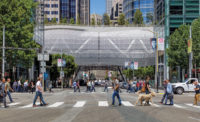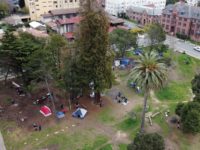Record-breaking pollution levels in Beijing this winter are one visible symptom of the bind China has gotten itself into with its rapid urbanization and infatuation with the automobile. As China accelerates its urban development to accommodate an estimated 300 million people moving from the countryside to cities by 2020, it is turning to people like California architect and planner Peter Calthorpe to help it design better cities—and quickly.
“You have to recalibrate your brain when you work in China,” says Calthorpe. “It’s not like the U.S., where we take tiny little steps in redevelopment and then fight over them for the next 10 years. In China, you’ll see cities designed for one and two million people built from scratch in a few years. The question is: how do you turn that activity into something benign?”
Calthorpe, who helped pioneer the movement known as the New Urbanism back in the early 1990s, is probably best known for helping Portland, Oregon, become a model for mass transit and hipster bicyclists. New Urbanism promotes neighborhoods with a mix of housing and commercial uses that can be easily navigated by pedestrians and bicyclists. Calthorpe first worked in China back in 2002, doing a city plan in Tianjin for some private developers. After he groused to a friend at the nonprofit Energy Foundation that China’s sustainability efforts were too narrowly focused on renewable energy, the foundation asked him to create design principles for Chinese cities to minimize their carbon footprint. In 2009, officials in Beijing awarded him two out of eight Eco-District pilot projects planned nation-wide.
In Kunming, Calthorpe has designed Chenggong New Town, reworking an existing master plan for the central district by organizing the densest areas around the transit stations, turning the main thoroughfares into couplets of one-way streets, adding pedestrian walkways and local streets, and creating a network of open spaces. Work has begun on the town with roads, parks, businesses, a high-speed rail station, and blocks of housing now under construction. A second project, Yuelai Eco-City, is one of 17 transit-oriented developments (TODs) that Calthorpe has designed for the northern Chongqing area. Yuelai Eco-City is scheduled to break ground on its 2,500-acre site this summer and will eventually accommodate 100,000 to 250,000 residents.
One of the big problems Calthorpe sees in China is the segregation of uses into single-function areas that lack diversity. “If everyone’s going downtown in the morning and leaving in the evening, you get massive congestion,” he says. “If you zone for mixed-use around transit stations, you have a better chance of getting the right balance of jobs and housing.” Calthorpe has fine-tuned the concept of TODs based on his experiences in other countries, emphasizing the need to match density to transit capacity. Yuelai Eco-City will have only two subway stations (on one metro line), so its layout focuses more on housing and less on commercial uses. On the other hand, Chenggong New Town will have a high-density commercial center at the intersection of two transit lines.
To coax people back to walking and biking, Calthorpe is also implementing something unthinkable in the U.S.: auto-free streets. “The density is so great here, you can really take out the cars and the streets will still be filled with people,” he says. It’s all part of his plan for defeating the “superblock”—Soviet-style mega-developments that stretch for more than 400 meters, separated by multi-lane roads. Calthorpe proposes a much finer grid: blocks that are 90-150 meters long and are divided by a mix of local streets, auto-free streets, pairs of one-way roads, and, ideally, a high-capacity transit stop every 800 meters. In Chenggong New Town, he is replacing the city’s current arterial road with a pair of one-way streets separated by a greenbelt. “It will reduce delays for through traffic while encouraging pedestrians,” he says. Located in a mountainous area, Yuelai Eco-City will have escalators (like those in Hong Kong) to handle the steepest slopes, and a series of streets that are auto-free but serviced a fleet of electric buses.
Smaller blocks promote a return to the traditional Chinese courtyard layout for buildings and the kind of ground-floor shops that are being displaced by giant enclosed malls. “Instead of destroying the urban fabric, we want to encourage local economies, fresh food, and busy streets that people already have and like now,” says Calthorpe.








Post a comment to this article
Report Abusive Comment